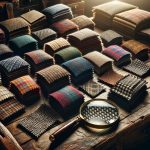I've always been intrigued by the debate over whether tweed suits are better than regular suits. Tweed's got that rugged charm and durability that seems perfect for colder months, plus it's got a style that really stands out with its rich textures and patterns. Regular suits, on the other hand, offer more variety and are usually a bit lighter, making them ideal for year-round wear and formal settings. It's a tough call, and I'm leaning towards one, but I'm curious to hear what others think about this. What's been your experience? Which type do you think offers more bang for your buck?
Table of Contents
Key Takeaways
- Tweed suits offer superior durability and longevity compared to regular suits due to their tightly woven fabric.
- Tweed is ideal for colder seasons, providing better insulation and moisture wicking than lighter suit materials.
- Due to its sophisticated textures and tones, tweed holds a timeless appeal, enhancing style versatility.
- While tweed has a higher initial cost, its durability can make it a more cost-effective choice in the long run.
- Maintenance of tweed suits is specific but manageable, involving regular brushing and careful dry cleaning.
History of Tweed Suits
Tweed suits, originally crafted to endure the harsh Scottish climate, have been a staple of classic fashion since the 18th century. Delving into tweed origins, it's fascinating to see how this rugged fabric evolved. Tweed was initially handmade by locals on the Scottish islands, primarily for its durability and resistance to cold, damp weather. It wasn't just a fabric; it was a necessity.
As I explore further, it becomes clear that tweed's journey from a practical garment to a symbol of sartorial elegance is intertwined with fabric innovations that refined its texture and style. By the 19th century, tweed had caught the eye of the aristocracy, particularly for hunting and outdoor activities. This endorsement shifted tweed's image from purely utilitarian to an element of elite lifestyle.
Innovation didn't stop there. Technological advancements in weaving and dying techniques allowed for a broader range of patterns, colors, and lighter weights, making tweed more versatile. These innovations opened up new avenues for tweed, evolving it from its outdoor roots to a fashionable option for everyday wear. It's this blend of tradition and innovation that cements tweed's revered status in fashion circles today.
Characteristics of Regular Suits
While tweed suits boast a rich history and unique qualities, regular suits offer a different set of characteristics that cater to various styles and occasions. Let's explore what makes these suits stand out.
The versatility of regular suits starts with the variety of fabric types available. You're not stuck with just one texture or weight; there's a whole spectrum from lightweight linens perfect for summer weddings to rich wool blends ideal for the boardroom. This flexibility means you can tailor your suit not just to fit your body but also to suit the season and setting.
Speaking of suit tailoring, it's an art that really lets regular suits shine. A well-tailored suit flatters any body type, enhancing your posture and boosting your confidence. It's not just about looking good; it's about feeling good too. Tailors can adjust every aspect, from the width of the lapel to the length of the trousers, ensuring a perfect individual fit.
Here's a quick comparison of fabric types and tailoring options available in regular suits:
| Feature | Description |
|---|---|
| Fabric Types | Linen, Cotton, Wool, Silk, Synthetic Blends |
| Tailoring | Custom-fit, Off-the-rack, Bespoke Options |
| Style Adaptability | From casual to formal settings |
| Seasonal Suitability | Suits for all seasons |
| Versatility | Wide range of colors and patterns |
As you can see, whether it's adapting to a summer soirée or a winter gala, regular suits have got you covered. Remember, it's all about choosing the right suit for the right occasion.
Durability Comparison
When it comes to durability, tweed has a reputation for lasting a long time.
Let's talk about why tweed might outlast your average suit, considering factors like its wear and tear.
We'll look at what makes tweed so tough and how regular suits compare when it comes to holding up over time.
Tweed Longevity Factors
Several factors contribute to the impressive durability of tweed compared to regular suits. Originating from Scotland and Ireland, tweed's toughness stems from its traditional woolen weave. The fabric's natural resilience to harsh weather aligns with its historical use by farmers and hunters needing reliable, long-lasting attire.
Recent innovations in tweed production have only boosted this durability. By incorporating modern fibers with traditional wool, manufacturers have enhanced the fabric's strength without sacrificing its classic appeal. This blend guarantees that tweed suits withstand daily wear much better than most conventional suit materials.
Understanding these aspects helps explain why tweed remains a preferred choice for both style and substance among knowledgeable suit wearers.
Suit Wear and Tear
Having explored tweed's durability, let's now compare how tweed suits stand up to regular suits regarding wear and tear. Tweed's robust nature means it resists wear impressively. Its tightly woven fabric not only handles frequent use but also maintains its structure better than many lighter materials found in regular suits. This resilience translates to less worrying about snags or tears during everyday activities.
Material flexibility in regular suits allows for more movement, which is great for comfort but can sometimes compromise the suit's longevity. Meanwhile, tweed's stiffer texture might limit flexibility but boosts durability. Additionally, tweed holds onto its colors longer, providing excellent color retention compared to the often-fading hues of regular suits. So, if longevity is your goal, tweed's the way to go.
Style Versatility Analysis
Tweed suits offer remarkable style flexibility, easily moving from formal events to casual outings. The color impact and pattern flexibility inherent in tweed fabrics enable this versatility. You're not just stuck with the typical shades of gray or navy found in more traditional suits; tweed allows for a richer palette of colors. Think deep greens, rustic browns, and vibrant blues. This variety means I can tailor my outfit to the occasion without a hitch.
Moreover, the patterns in tweed—like herringbone, check, and plaid—add a layer of visual interest that can be dialed up or down depending on what I pair with the suit. For a board meeting, I might choose a subtle herringbone with a crisp white shirt and leather brogues. Switching to a weekend look, I can keep the same suit but throw on a turtleneck and some sneakers. It still works, and that's the beauty of tweed.
In essence, tweed's diverse color options and engaging patterns not only broaden my wardrobe choices but also denote a sophisticated understanding of style. It's about knowing how to play with textures and tones to craft the perfect look for every occasion.
Comfort and Fit Considerations
When considering tweed suits, comfort and fit really stand out, especially compared to more rigid, traditional suit fabrics. Here's why I've found them more agreeable for daily wear:
- Fabric Breathability: Tweed's natural fibers allow for better air circulation compared to many synthetic blends used in regular suits. This means I'm not only looking sharp but also feeling cool and less stuffy during longer wear. It's a game-changer in crowded rooms or during stressful presentations.
- Flexibility: Unlike some stiff suit materials, tweed has a bit of give. This flexibility means the suit moves with me, making it ideal for everything from sitting through meetings to rushing through transit hubs.
- Durability: Though soft, tweed is incredibly resilient. I've noticed it doesn't wrinkle as easily as finer suit fabrics, which means less fuss and more time focusing on what matters. Plus, it holds its shape, ensuring a consistently good fit.
- Allergy Considerations: For those sensitive to synthetic materials, tweed is a blessing. Being primarily wool, it's less likely to trigger allergic reactions, which is essential for comfort throughout wear.
Seasonal Suitability
When it comes to picking the right suit for the season, tweed is a standout for winter warmth.
However, I've found that regular suits might take the lead in summer for their lighter comfort.
Let's look at how each type fares as the seasons change.
Tweed's Winter Warmth
I've found that a tweed suit offers unmatched warmth during the chilly winter months. This isn't just a style choice; it's about understanding the material science behind tweed and how its insulation technology keeps the cold out. Here's why tweed is ideal for winter:
- Density: Tweed's thick, tightly woven fibers trap heat efficiently.
- Natural Material: Wool, the primary component of tweed, is known for its excellent insulation properties.
- Layering Capability: Tweed's robust texture allows for comfortable layering without feeling bulky.
- Moisture Resistance: Tweed wicks away moisture, keeping you dry and warm even in snowy conditions.
Mastering winter fashion means choosing the right materials, and tweed's qualities make it a superior choice for the season.
Summer Suit Comfort
Tweed suits, while perfect for winter, can feel too heavy and warm for the summer months. If you've ever worn one in July, you know it's not the most comfortable choice. Summer demands suits with fabric breathability. This is where lighter materials like linen and cotton come into play. They allow air to circulate, keeping you cooler.
Also, the color options for summer suits are generally lighter, reflecting rather than absorbing the sun's rays. Think crisp whites, soft beiges, or cool pastels, which can make a significant difference in your comfort levels. So, when it's hot out, I'd steer clear of tweed and opt for something less insulating. Trust me, your summer self will thank you.
Cost and Value Insights
Evaluating the cost-effectiveness of tweed compared to regular suits, it's clear that several factors come into play. Here's a breakdown to help you see why:
- Initial Expense: Tweed suits often carry a higher initial cost than many standard suits. This is due to the unique materials and the intricate weaving process typical of tweed. But don't let that initial price tag deter you.
- Durability: Tweed is notoriously durable. This robust fabric withstands wear and tear much better than most suit materials, potentially saving you money on replacements or repairs over time.
- Investment Potential: A well-maintained tweed suit can last decades and even become a wardrobe staple. Its timeless appeal means it never really goes out of style, making it a smart investment that might pay dividends in terms of usage and style longevity.
- Maintenance Costs: Tweed is low maintenance due to its resistance to dirt and less frequent need for dry cleaning. This can add up to significant savings throughout the suit's lifespan.
Occasion Appropriateness
When considering what to wear for various events, it's important to recognize that tweed suits often excel in more formal and traditional settings. Whether it's a countryside wedding or a high-profile business meeting, tweed brings a level of sophistication that's hard to match with regular suits. The rich texture and typically earthy tones convey a sense of heritage and formality that's perfect for making a distinguished impression.
However, don't be fooled into thinking that tweed can't adapt to casual settings. This versatility is what makes tweed stand out. For a more laid-back occasion, such as a casual dinner with friends or a weekend outing, tweed can be effortlessly styled down. Pairing a tweed blazer with jeans or chinos offers a smart-casual look that's stylish yet not overly formal.
In essence, tweed suits bridge the gap between formal events and casual settings seamlessly. They lend an air of authority and tradition to formal occasions while still being adaptable enough to fit into more relaxed environments. This adaptability makes tweed an invaluable addition to my wardrobe, ensuring I'm well-prepared for a wide range of social situations.
Maintenance and Care
Now, let's talk about how to take care of your tweed suit so it lasts longer and stays sharp.
Cleaning a tweed suit isn't as straightforward as your regular suit, and storing it properly is essential to avoid damage.
We'll also look at the longevity of tweed fabric to see if it's really a better investment.
Cleaning Tweed Suits
Caring for your tweed suit requires specific steps to maintain its unique texture and longevity. Here's how I keep mine in top shape:
- Dry Cleaning: It's essential. I always opt for a professional dry cleaner familiar with tweed to prevent any damage.
- Brushing: Regularly, I use a soft garment brush. This helps remove surface dirt and maintains the fabric's integrity.
- Stain Removal: Immediate attention is key. I blot spills with a clean cloth and sometimes use a mild stain remover that won't harm the fabric.
- Spot Cleaning: For small, stubborn spots, I apply a gentle cleaning agent with a damp cloth, being careful not to saturate the material.
Storing Tweed Properly
To keep my tweed suit in prime condition, I store it carefully to avoid any crumples or damage. I've learned that the right fabric selection can make a huge difference. Tweed is durable, but it still needs tender loving care. I always use padded hangers to maintain the shape of the jacket and avoid wire ones that can distort the shoulders.
Humidity control is essential, too. Too much moisture can lead to mold, while too little can dry out the fabric. I keep silica gel packets in my closet to manage the moisture levels effectively. This simple trick helps maintain the integrity of the tweed's texture and ensures it's ready to wear without unexpected surprises.
Longevity of Tweed Fabric
While proper storage is key, regularly maintaining your tweed suit also plays a significant role in its longevity. Here's how I keep my tweed looking sharp:
- Brush Regularly: I use a soft clothes brush to gently remove dirt and preserve the fabric's integrity.
- Spot Clean: Immediate attention to spills prevents set-in stains. I dab (not rub) the spot with a damp cloth.
- Air Out: Instead of frequent washes, I air my tweed out. This method reduces wear and protects the natural oils within the wool.
- Professional Cleaning: Once a season, or as needed, I opt for dry-cleaning to maintain the tweed's texture and color.
Mindful care of tweed suits lessens their environmental impact by extending their life, aligning with sustainable tweed production practices.
Fashion Trends and Popularity
One can't overlook how tweed has surged in popularity, reshaping fashion trends with its distinctive style. Let's explore this fabric's journey.
Tweed's origins trace back to Scotland and Ireland, where it was primarily used by farmers for its durability and moisture resistance. This essential beginning is important, but it's the modern adaptations that have propelled tweed into the fashion spotlight. Designers are reimagining tweed in contemporary cuts and colors, making it a staple not just in traditional countryside gear but in urban chic attire as well.
Now, tweed isn't just for autumn anymore. I've seen it worn brilliantly at spring weddings and summer evening events. It's become a year-round contender against regular suits that often stick to predictable patterns and fabrics. The texture and depth of tweed provide a visual interest that plain suits can't match, making it a standout choice for those looking to elevate their style game.
Furthermore, tweed's versatility allows it to be dressed up or down, blending seamlessly with various accessories and footwear, which broadens its appeal. It's clear that tweed's evolution from a rugged, rural fabric to a fashion-forward option demonstrates its rising dominance in the style stakes.
Frequently Asked Questions
Can Tweed Suits Be Tailored to Have a Modern Slim Fit?
Yes, tweed suits can definitely be tailored for a modern slim fit. Tailoring trends have evolved, and the fabric's flexibility allows for such adjustments, ensuring a sleek, contemporary look without compromising traditional charm.
Are Tweed Suits Considered Hypoallergenic Compared to Regular Suits?
I'm not aware of tweed suits being specifically hypoallergenic. Both tweed and regular suits can trigger allergies depending on the fabric allergens present and how you maintain the suit. Always check the material used.
Do Tweed Suits Offer Better UV Protection Than Regular Suits?
Yes, tweed suits do offer better UV protection due to their thicker fabric and tighter weave. This added thickness and durability also means they're generally more resilient against wear and tear.
Are There Vegan Alternatives to Tweed and Regular Wool Suits?
Yes, there are vegan alternatives to both tweed and regular wool suits! They're part of fabric innovation in sustainable fashion, using materials like hemp, bamboo, and recycled polyester. It's eco-friendly and stylish!
How Do Tweed and Regular Suits Impact the Environment Differently?
Tweed production often has higher emissions due to its processing and dyeing. However, if sourced sustainably, tweed can outshine regular suits in material sustainability, potentially lessening overall environmental impact.
- Is Tweed Better Than Regular Suits? - April 24, 2024
- Why Is Tweed so Popular? - April 24, 2024
- Are Tweed Suits Worth It? - April 24, 2024








